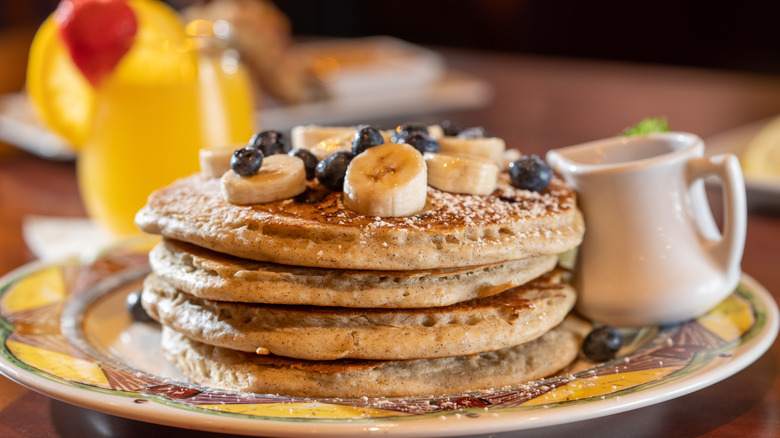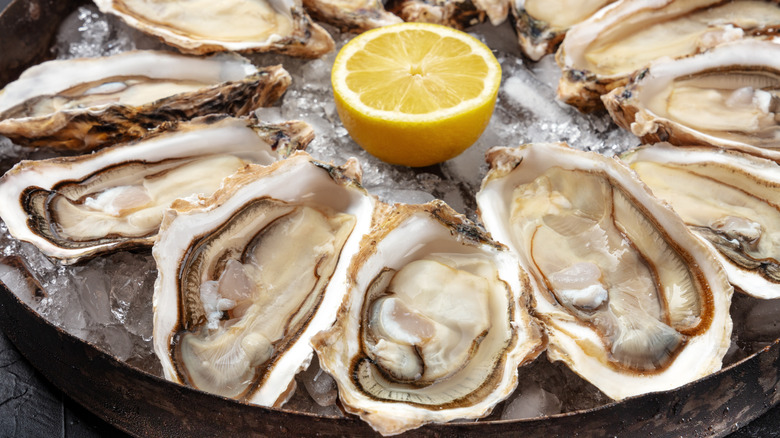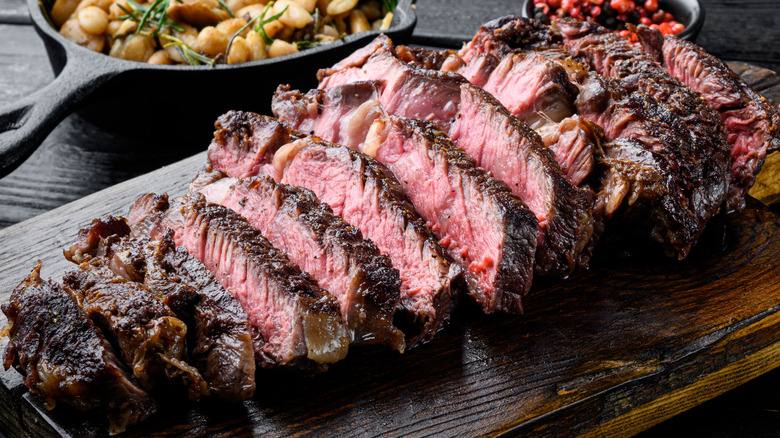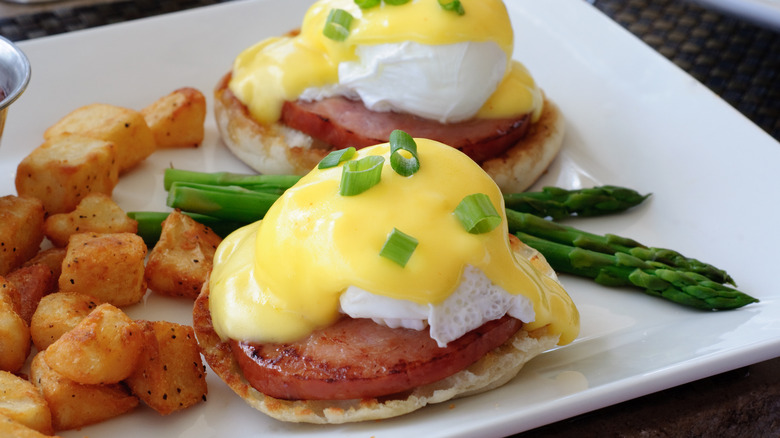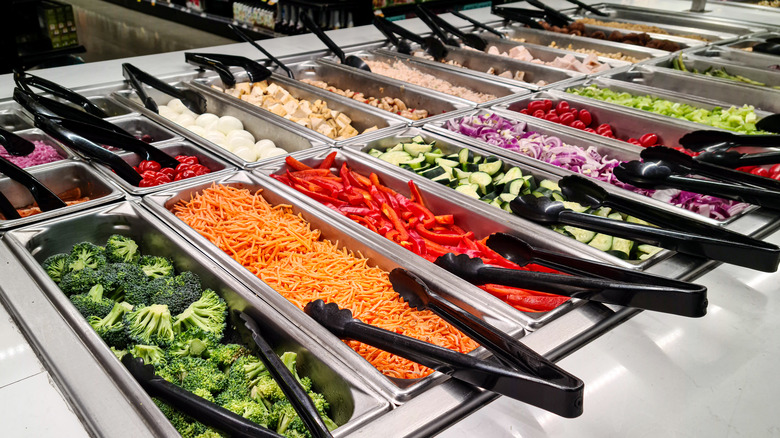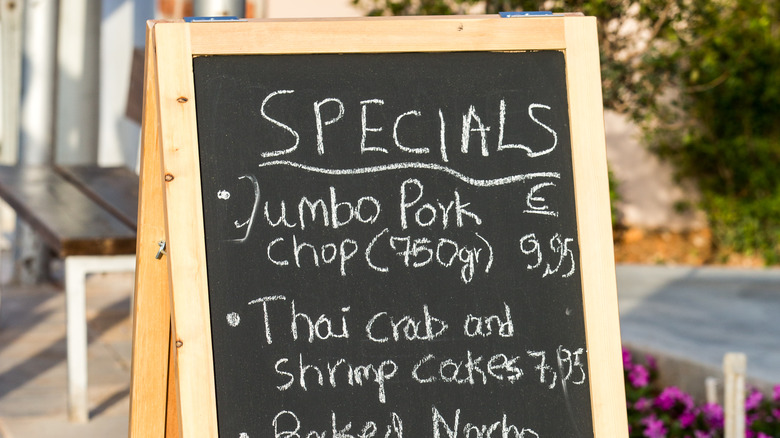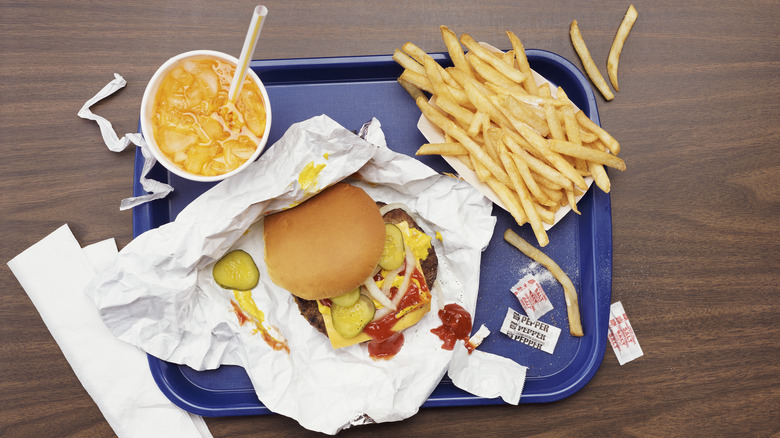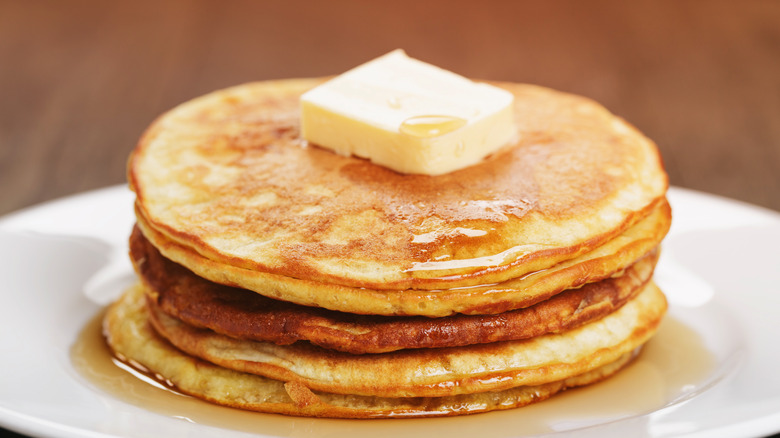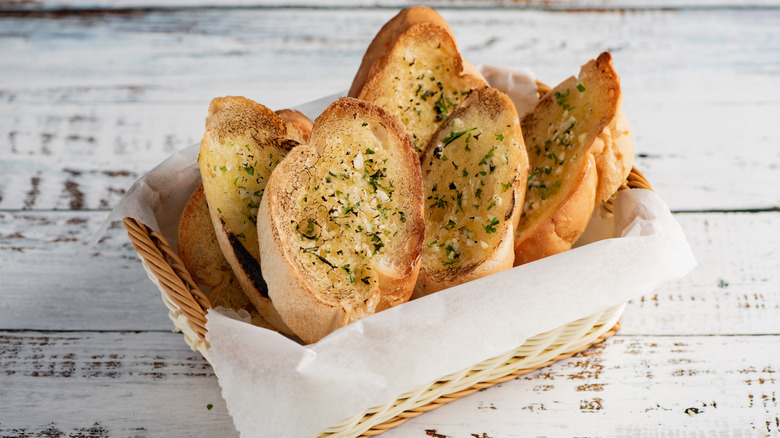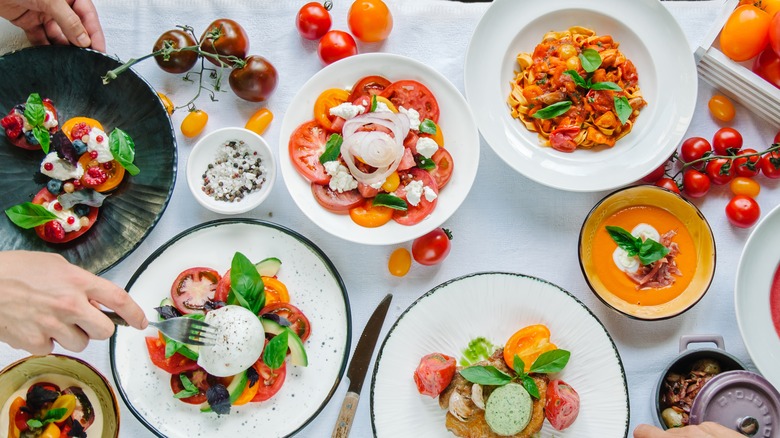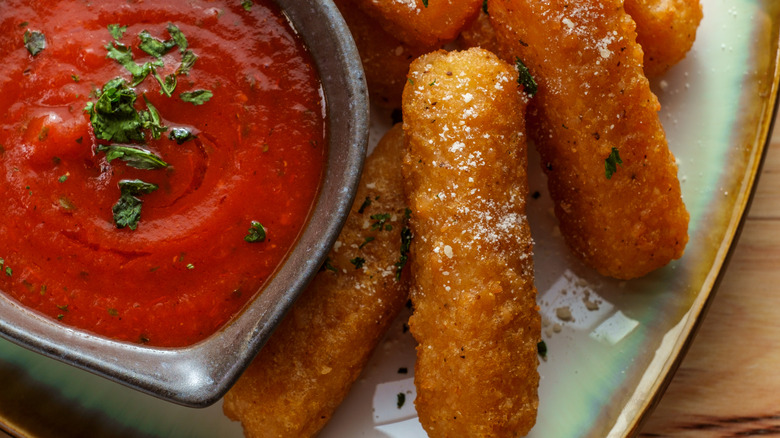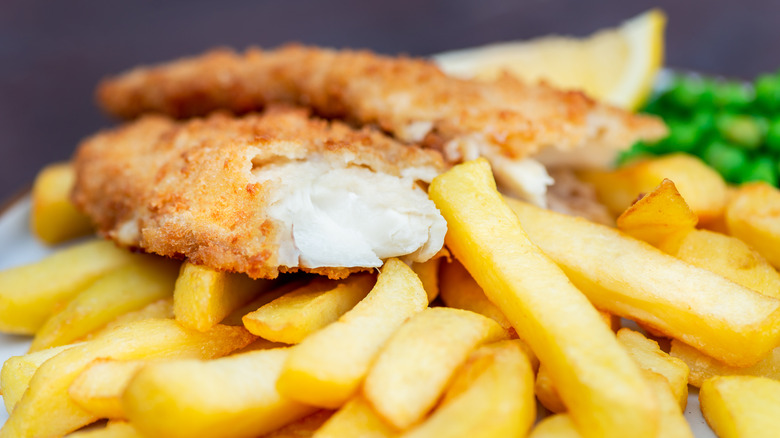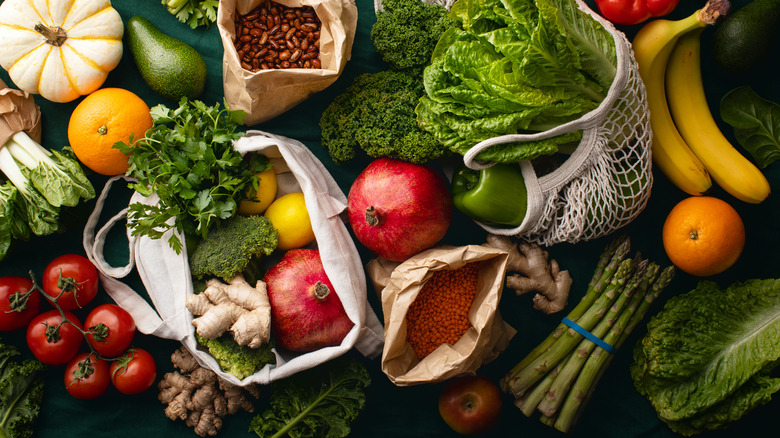12 Things You Should And Shouldn't Order At A Cheap Restaurant
While some menu items are best kept for a pricey night out on the town, don't completely give up when deciding to be friendly to your wallet. Whether you're dining in or ordering takeout, being a little choosy is where your mind should be. With an endless array of options from small mom-and-pop shops like diners, to large, inexpensive chain restaurants, there are ways you can avoid going broke over a single meal while still enjoying your time away from the kitchen.
If frugal is the game, knowing which items to go for and those to avoid can get you just enough of the quality experience you're searching for. From frozen seafood to free bread, there are a few things to be aware of when aiming for a cheap date with yourself or others. When factors like taste, texture, and freshness are at stake, here's what to try and what to reconsider.
Don't order: oysters and other seafood items
According to Thrillist, it isn't uncommon for fish items to lack in the freshness department. One way to know if something on a cheap menu is waving an unassuming red flag at your face, is if most seafood options are fried. Typically, this is an indication that the fish came in frozen to begin with.
When debating whether or not to go for the oysters, you can assume they are of quality when served fresh-shucked and arrive on your plate in the half shell. If a restaurant deems their oyster option "oysters Rockefeller," you're most likely in for some sub-par tasting grub, as low-cost eateries usually order those frozen as well. As a rule of thumb, a place that doesn't have fresh-shucked oysters available most likely isn't serving more common fare like salmon, cod, sea bass, or tuna, fresh either. A better option is to opt for a restaurant offering local seafood instead.
The FDA's website tells us that when looking to purchase frozen fish, the contents of the bag should never be able to bend, as this is a food safety concern. If dining out, it may be more difficult to assess the quality of the product you're eating. As an alternative, make sure to ask your server if the fish arrives fresh every day.
Don't order: steak
Steak can be a tricky affair to order at any restaurant, given that every customer has a preference for how their meat is cooked. Much like ordering a burger, it is safe to assume that no steakhouse serves its meat exactly the same.
Forbes informs us that top-notch steakhouses have resources available to them that cheaper restaurants don't. The first is utilizing suppliers that offer prime cuts. A factor like this will often determine the price of your steak. Whereas low-cost eateries may feature steak on their menu, it isn't likely that their meat is supplied in a way that is customized for them.
Expensive steakhouses are also likely to be equipped with dry-aging cabinets for the meat to hang from, in turn letting it produce flavors that are enhanced over time. This simply may not be an option when dining at a low-priced restaurant. Smaller, time-consuming steps known to amplify a steak's quality, such as letting it sit at room temperature before cooking, using flaked salt instead of table salt to intensify flavor, as well as pre-seasoning for maximum taste, are all steps you'll have better luck in finding at restaurants specializing in steak, rather than a run-of-the-mill diner (via Steak School).
Don't order: eggs Benedict
Eggs Benedict, a popular brunch dish consisting of two eggs atop an English muffin or biscuit, typically served with thick cut ham, is one menu option you may want to reconsider when dining on the cheap. Served under a velvety smooth hollandaise sauce, a recipe whose primary ingredient is egg yolks, can be a welcoming place for bacteria to build up, according to She Finds. Hollandaise sauce isn't often made to order in restaurants serving brunch, meaning you could be challenged with a food safety issue if ordering from a cheap restaurant whose goal is quantity over quality.
Some spots work leftovers from the previous day into their menu for convenience, so freshness is far from guaranteed. With hollandaise sauce needing to be carefully kept at a specific temperature to avoid microorganism formation, this may be neglected at cheaper restaurants. Based on the information provided by the USDA, there is a certain amount of time deemed safe to be leaving food out, if at room temperature, and that's typically a couple of hours. Otherwise, bacteria like salmonella have an opportunity to tag along with your meal, and who needs that?
Don't order: the salad bar
Salads can be a healthy option to choose when dining out, though it's smart to check how it's being made first. If salads are hand-tossed, you might want to see what other choices are on the table. It's common for cheaper places like diners to serve pre-cut green leaves, instead of a fresh option prepared in-house, Insider tells us. As for your salad sauce, it's not unusual for inexpensive places like diners to provide mass-produced dressings instead of making them from scratch. With a higher volume of customers, the less likely you'll get food made that same day.
In an article from Reader's Digest, where past restaurant workers were interviewed about food safety concerns they noticed while on the clock, one worker expressed a sad truth about why it's best to rethink the salad bar. While lettuce may get replaced daily, toppings like olives, beets, and beans may not be changed out for weeks at a time, mainly because they aren't as popular. It's perhaps best to try your luck elsewhere if you'd like a salad, preferably at a local spot serving seasonal greens.
Don't order: the daily special
Specials offered on a menu could indicate a couple of things for the hungry customer. Courtesy of Reader's Digest, specials can be a way for a restaurant to showcase its creativity with different ingredients and coming up with new ways to prepare them. It also allows chefs to use pricier ingredients they normally wouldn't be able to include on their everyday menu. In essence, it offers an opportunity for eateries to see if a new idea could take off with the potential of being offered more consistently, without spending as much money as would be necessary if it was offered as a regular menu option.
Though there's another reason you might see an exciting new special on a menu. On the other hand, specials are also a stand-in for restaurants to get rid of expiring ingredients (via New York Post). If a restaurant has over-ordered a batch of squash, for example, it is likely that the vegetable will be incorporated as a temporary menu option to save some money. While avoiding food waste is something every restaurant should strive for, the best time to try a restaurant's special is when it's seasonal, featuring ingredients whose time to shine is the present.
Don't order: certain takeout items
You'll want to carefully assess your choices if you're craving something from the comfort of your own home. Although the quality of most food isn't helped when traveling from point A to point B, there are some popular menu items that you're better off avoiding altogether.
Anything fried, particularly when ordering from cheap chains, isn't super travel-friendly we learn via Time Out. You might experience soggy calamari if time was not on the delivery person's side. French fries are in a similar boat, and will not be the golden deliciousness they once were before being trapped into a box, causing steam and moisture retention.
According to the Daily Meal, chicken wings also have a delivery shelf as they'll choke under the captivity of a to-go box, leaving the skin floppy, and losing its crunch factor. If they are drenched in sauce, this will also contribute to a loss in texture. Nachos and other dishes featuring cheese you might find at a cheap restaurant are not ideal either, as corn tortillas meant to be a vessel for nacho toppings will retain the cheese's dampness and bend. The message here? Avoid foods that don't do well when hanging around too long before reaching the final destination of your stomach.
Do order: classic breakfast items like pancakes
When you think "diner" you're most likely envisioning mile-high stacked pancakes drenched in maple syrup, thick, frothy vanilla and chocolate milkshakes, or a hefty helping of warm disco fries. Via Insider, these are exactly the types of menu items you'd want to look out for if eating at a diner, even a less expensive one at that.
Pancakes are a safe bet, particularly if Canadian or Vermont maple syrup is being offered alongside it. Milkshakes from diners, even when priced low, maintain their consistency thanks to restaurant-grade mixers. A difficult recipe to pull off at home if you don't have this kind of machinery, you're most likely going to enjoy an inexpensive diner milkshake over a homemade one, courtesy of your lacking blender.
Hashbrowns and home fries are also winning items, and that's because most diners have griddles to cook their potatoes on. This small but essential detail allows for potatoes to crisp up. You can also count on diner-style scrambled eggs if you're in search of a nice fluffy meal due to a secret ingredient occasionally added in ... pancake mix. These options are going to be more bang for your buck, as pasta with a red sauce or soup is not always made from scratch at cheaper restaurants and rather comes canned, according to Insider.
Do order: bread in loaf form
You're at a restaurant and there it is: complimentary bread. Laying in a basket, divided into slices, awaiting your hunger. The dilemma? It might not be fresh, or even worse, it might not be the first time it's hit someone's table.
So, what does this mean for the cheap foodie? Courtesy of Reader's Digest, it's not uncommon for people to leave their bread baskets unfinished, especially if bread is complimentary and comes to the table automatically (via The Manual). As a result, some restaurants will save the remains for the following guests. And now it's at your table, wide-eyed and ... not so bushy-tailed. But don't let this deter you.
There's one way to enjoy this pre-appetizer treat while making sure you aren't getting anyone's leftovers. Try ordering it presented in a different way than the restaurant is serving it. For instance, if you notice most customers have their bread in slices, ask your server if you can order a loaf instead. This will ensure that there's been less tampering with your delicious carb.
Via Food52, we learn that bread that has been pre-sliced also loses its texture faster. It's harder to keep it fresh for extended periods of time, and ordering a whole loaf gives you the advantage of cutting pieces up as you go, this way the bread is intact for longer.
Do order: à la carte
Ordering à la carte proves to be an effective option for cheap dining. How does ordering this way keep your wallet happy? Ordering à la carte is a French term used to describe a method in which you order food from a restaurant a little less traditional than you'd expect. If a menu offers a fixed price with several courses included, ordering à la carte simply means you're ordering items individually instead. Some restaurants offer this option, and with it comes more flexibility. An à la carte menu will offer smaller plates, so you can get a little bit of everything should this suit your fancy, according to Delighted Cooking. With a system like this, menu items are also single-priced.
Popular in fine dining, this manner of ordering food is not limited to expensive eateries. Cafeterias and family restaurants also have this option. A style along the likes of buffet dining would be the opposite, in which diners pay a flat fee in exchange for their choice of bites being served. Courtesy of dining tips blog Art De Grange and Reddit, while it may be worth it to pay a little extra for an all-you-can-eat situation, consider ordering items separately so you're getting exactly what you want.
Do order: items that cannot be pre-made
For restaurants serving a high volume of customers, there's a chance you may be sacrificing taste for a microwaved meal. Via McDonaldPaper, we learn that some places claim dishes as their own creation despite it having been purchased from a large food supplier.
This option ensures that menu items will taste the same every time. How can you avoid foods that may be pre-made? If the place you're dining in has an extensive menu, this could also be a sign that their food does not require much prep, most likely because it was simply warmed up before being served.
It isn't uncommon for food suppliers to deliver desserts and entrees to cheap restaurants like chains. Previously made cakes, muffins, soups, and appetizers are commonly supplied to restaurants with one thing in mind — consistency. In the fast food industry, most menus are incredibly consistent across locations, according to The Daily Meal. From recipe development to serving sizes, this guarantees customer loyalty. So if you're looking for a night out specifically on the cheaper side, you might want to scan the menu first for dishes that are not microwavable friendly.
Do: try the restaurant's most popular items
When deciding what to order that'll be worth your time and money, there's one thing to try that'll be sure to narrow down your choices: go for the restaurant's most popular items. There are a couple of reasons why sticking with this rule is especially useful.
Firstly, a restaurant's most popular items are often a reflection of how well-received they are by customers, according to Deputy. If you notice the loaded fries are frequently praised in online reviews, your best bet is to see for yourself. If it's a best-seller, there's an increased possibility the restaurant has perfected the recipe, and continues putting more effort into cooking a dish that keeps its customers coming back.
To take this method a step further, try a place whose name includes a specific food item. This is a surefire way of seeing what they're known for. Even if aiming for inexpensive eats, try a place like "Sam's Fish and Chips" instead of a place that doesn't specify what they're famously serving.
Do order: menu items with seasonal ingredients
Ingredients closer in proximity to the place serving them typically makes for a fresher meal. There are a few reasons why you shouldn't underestimate a restaurant supplied by local ingredients, even if the experience is inexpensive. Although it may often sound like a pricier option, restaurants typically pay less for seasonal produce.
Fruits and vegetables from a local vendor will be provided seasonally, according to Mr.Yum. This makes for flavors that are robust, adding a value you won't get if eating produce that hasn't reached its peak goodness yet. It's also less likely for seasonal products to have to be discarded due to a lack of quality. Logistically, restaurants can dodge excess food waste by getting these ingredients for a great price, as produce that is in season is more plentiful. In some cases, restaurants may grow and harvest their own produce. Where ingredients are being delivered in season, it isn't uncommon for the menu to change with it, as well. Take a chance at a sustainable place featuring fresh produce.
